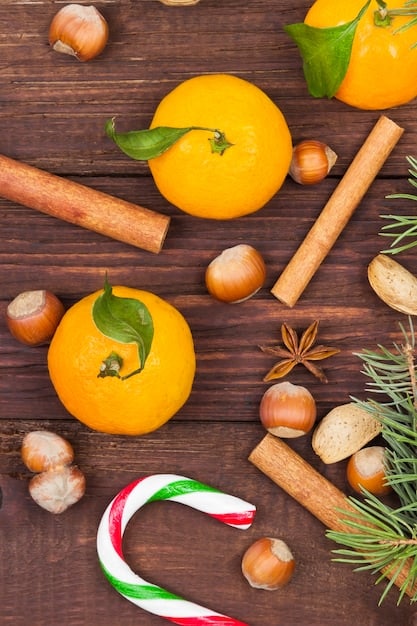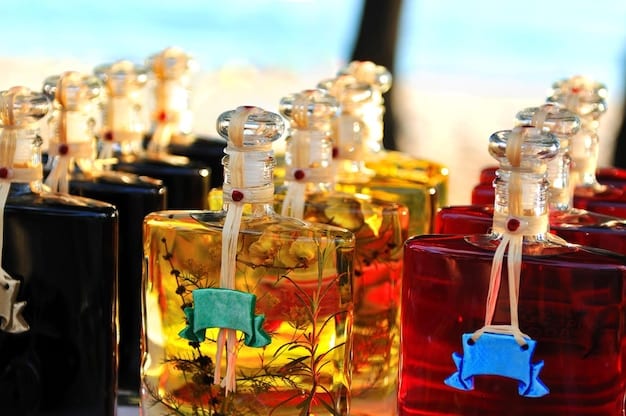Fragrance for Beginners: Your Guide to Finding the Perfect Scent

Fragrance for Beginners: A Step-by-Step Guide to Finding Your Signature Scent provides a comprehensive introduction to the world of perfumes, helping you navigate different fragrance families, understand scent layering, and ultimately discover a scent that perfectly reflects your personality and style.
Embarking on the world of fragrance can feel overwhelming, with countless scents and technical terms. This Fragrance for Beginners: A Step-by-Step Guide to Finding Your Signature Scent demystifies the process, making it an enjoyable journey of self-discovery.
Understanding Fragrance Families
One of the first steps in your fragrance journey is understanding the different fragrance families. These families categorize scents based on their dominant characteristics, helping you narrow down your preferences. Let’s dive in to know more.
Floral
Floral fragrances are among the most popular and recognizable. They evoke the scent of fresh flowers, often featuring notes like rose, jasmine, lily, and tuberose.
Woody
Woody fragrances are warm, earthy, and often feature notes like cedarwood, sandalwood, vetiver, and patchouli. They can be both masculine and feminine.
Here’s a breakdown of common fragrance families and their characteristics:
- Floral: Sweet, romantic, and feminine, reminiscent of blooming gardens.
- Woody: Earthy, warm, and sophisticated, often with a grounding and comforting effect.
- Citrus: Fresh, zesty, and invigorating, perfect for daytime wear and warmer weather.
- Oriental: Spicy, warm, and exotic, often featuring notes of amber, vanilla, and resins.
Understanding these families will help you articulate what you like and dislike, making the selection process easier.
In essence, fragrance families provide a framework for understanding different scent profiles, allowing you to explore and identify the types of fragrances that resonate with you.
Navigating Fragrance Notes
Fragrances are composed of different notes that unfold over time. Understanding these notes can enhance your appreciation and help you make informed choices. Let’s understand the concept of notes with this guide.
Top Notes
Top notes are the initial impression of a fragrance, the first scents you smell. They are typically light and volatile, lasting only a short time.
Middle Notes
Middle notes, also known as heart notes, emerge after the top notes fade. They form the core of the fragrance, providing body and complexity.

Here’s how fragrance notes interact to create a complete scent experience:
- Top Notes: Provide the initial burst of fragrance, attracting attention.
- Middle Notes: Develop the character of the fragrance, adding depth and complexity.
- Base Notes: Provide a long-lasting foundation, creating a lasting impression.
Learning to identify and appreciate these notes will allow you to understand the evolution of a fragrance on your skin.
In short, understanding fragrance notes enables you to appreciate the complexity and artistry behind perfume creation, giving you a deeper connection with your chosen scent.
Sampling and Testing Fragrances
The best way to find a fragrance is to sample and test it on your skin. This allows you to experience how the scent develops and interacts with your body chemistry. Skin chemistry also plays a role in this procedure.
Visiting Perfume Counters
Department stores and perfume boutiques offer a wide selection of fragrances to sample. Don’t hesitate to ask for assistance from sales associates.
Obtaining Samples
Many brands offer samples of their fragrances, either for free or for a small fee. This is a great way to test a scent without committing to a full bottle.
Here are some tips for effective fragrance sampling:
- Start with a small number of scents: Avoid overwhelming your nose by sampling too many fragrances at once.
- Spray on your skin: Fragrances smell different on paper versus on skin.
- Wait for the dry down: Allow the fragrance to develop fully before making a decision.
Sampling and testing fragrances on your skin ensures that you find a scent that truly complements you and becomes your signature.
Consequently, sampling and testing is an essential step in finding your signature scent, as it allows you to experience how a fragrance truly interacts with your unique chemistry and preferences.
Understanding Fragrance Concentrations
Fragrance concentrations indicate the strength of the perfume oil in the fragrance, affecting its longevity and intensity. This strength defines how the perfume will stay with you.
Parfum
Parfum has the highest concentration of perfume oil, typically 20-30%. It is the most expensive and longest-lasting fragrance form.
Eau de Parfum (EdP)
Eau de Parfum has a lower concentration of perfume oil, typically 15-20%. It offers a good balance of longevity and affordability.

Here’s a comparative overview of fragrance concentrations:
- Parfum: Highest concentration, longest-lasting, most expensive.
- Eau de Parfum: Good concentration, long-lasting, moderately priced.
- Eau de Toilette: Moderate concentration, moderate longevity, affordable.
- Eau de Cologne: Low concentration, short-lasting, inexpensive.
Choosing the right concentration depends on your preferences, budget, and the occasion for which you’ll be wearing the fragrance.
Thus, understanding fragrance concentrations empowers you to select a product that aligns with your desired intensity, longevity, and budget, ensuring you get the most out of your fragrance experience.
Scent Layering Techniques
Scent layering involves combining different fragrances to create a unique and personalized scent. This technique allows you to tailor your fragrance to your mood and style. It is an art with endless creative possibilities.
Using Complementary Products
Start by using complementary scented products, such as body wash, lotion, and perfume, from the same fragrance line.
Combining Different Fragrances
Experiment with layering different fragrances to create new and interesting combinations. Start with lighter scents and build up to heavier ones.
Here are some tips for successful scent layering:
- Start with a light base: Apply a light body lotion or oil as a base for your fragrance.
- Layer similar scents: Combine fragrances from the same family for a harmonious blend.
- Experiment with contrasting scents: Create intrigue by layering contrasting fragrances, such as floral and woody.
Scent layering allows you to express your individuality and create a fragrance that is uniquely yours.
As a result, scent layering provides a creative outlet for fragrance enthusiasts, allowing for endless customization and the ability to create truly unique and personalized scents.
Finding Your Signature Scent
Your signature scent is a fragrance that perfectly represents you, your personality, and your style. Finding it requires patience and exploration. It is like discovering a hidden part of yourself.
Consider Your Personality and Lifestyle
Think about your personality, your lifestyle, and the types of scents that resonate with you. Do you prefer light and fresh scents, or warm and sensual ones?
Seek Recommendations
Ask friends, family, or sales associates for recommendations based on your preferences. Be open to trying new and unexpected fragrances.
Here are some steps to help you find your signature scent:
- Reflect on your preferences: Consider the scents you naturally gravitate towards.
- Experiment with different families: Explore different fragrance families to discover new favorites.
- Trust your instincts: Choose a fragrance that makes you feel confident and happy.
Your signature scent should be a fragrance that you love and that makes you feel like the best version of yourself.
In summary, finding your signature scent is a deeply personal journey that reflects your individuality and style, resulting in a fragrance that becomes an extension of who you are.
| Key Aspect | Brief Description |
|---|---|
| 🌸 Fragrance Families | Floral, Woody, Citrus, and Oriental are key categories. |
| 👃 Fragrance Notes | Top, middle, and base notes create the full scent profile. |
| 🧪 Concentrations | Parfum, EdP, EdT, and EdC offer varying strength and longevity. |
| ✨ Scent Layering | Combine scents for a personalized fragrance experience. |
Frequently Asked Questions (FAQs)
▼
Eau de Toilette (EdT) has a lower concentration of perfume oils, making it lighter and shorter-lasting, while Eau de Parfum (EdP) has a higher concentration, resulting in a longer-lasting and more intense scent.
▼
Spray the fragrance on your skin (preferably your wrist or inner elbow) and allow it to develop for a few hours. This allows you to experience the top, middle, and base notes as they unfold.
▼
The main fragrance families include floral, woody, oriental, and citrus. Each family has distinct characteristics and appeals to different preferences based on individual tastes.
▼
Yes, layering fragrances can create a unique and personalized scent. Start with a light base and gradually add stronger scents, experimenting until you find a balanced and pleasing combination.
▼
The longevity of a fragrance depends on its concentration and your skin type. Parfum can last up to 8 hours, while Eau de Cologne may last only 2-3 hours. Individual skin chemistry can also affect duration.
Conclusion
Finding your signature scent is an exciting and personal journey. By understanding fragrance families, notes, concentrations, and layering techniques, you can confidently explore the world of perfumes and discover a fragrance that truly reflects you.





